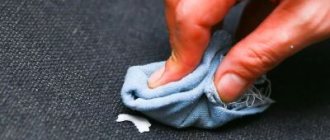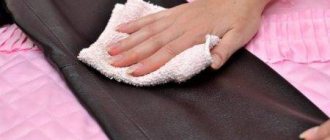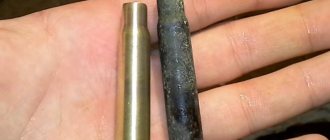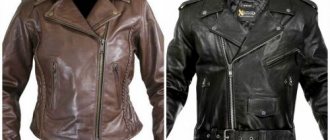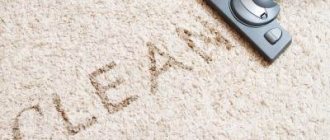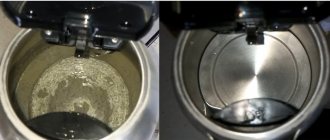What is dry washing and when is it needed?
Housewives often wash things by hand or in a machine, but some things deteriorate from prolonged exposure to water: delicate fabrics become rough, stretch or shrink. Among the capricious materials are velvet, cashmere, fine linen, cotton and lace. Leather, suede and fur do not tolerate washing well. If the clothes have embroidery or appliqué, washing them in a machine can ruin the decor.
It happens that you need to clean not only your clothes, but also your shoes. How to clean furniture upholstery, bulky textiles, carpets and fragile handmade decor?
Dry cleaning solves problems. This is a delicate cleaning of fabric using special or improvised means without complete immersion in water.
Pros of dry cleaning:
- Save time. Small stains can be cleaned yourself without going to the dry cleaner. Improvised means are cheaper than the services of a specialist.
- Effective in the fight against fat and oil. Powders absorb grease well, so they help remove any oil stains.
- Reduces the formation of pellets. The pellets appear from improper wear, friction in hand washing and the drum of the washing machine. Dry cleaning is usually carried out using dry products and a soft brush - this is a more delicate way of cleaning fabric.
The method also has disadvantages. If you have already washed the item, then cleaning will not help: the dirt has already penetrated deep into the fibers. In addition, it will not be possible to remove difficult stains using improvised means. Contact a dry cleaner: professionals will handle any type of dirt and provide a guarantee for the safety of the item.
Flaws
This processing method also has disadvantages. Solvents are great for removing grease and oil stains, but they are ineffective when the stains are water-based. Therefore, if the stain is washed at home using the dry method, it cannot be removed.
According to people's reviews, it is clear that solvents gradually spoil the product, since during drying they are not completely removed from the fabric. But this is not true, since the means and technologies used in modern dry cleaners have high surface activity, which increases with heating. Therefore, solvents along with stains are completely removed without causing harm.
Instructions and tips for home dry cleaning
First of all, sort your clothes by fabric type and color, just like you would for a regular wash. Next, prepare your items for cleaning:
- Place items in a laundry bag. This is a special container made of polyester or nylon, which protects the fabric from mechanical stress and prevents the appearance of pills and snags.
- Place a couple of cloth napkins soaked in cleaning solution in the middle of the bag. This is enough to prevent the material from drying out and becoming wrinkled.
- Select the “dry” mode on the washing machine and run it for half an hour at the minimum temperature.
- After the procedure, shake the fabric and walk over it with a brush to remove any remaining product.
Carefully hang things on hangers and leave to dry. To remove heavy stains, treat stains with a detergent before drying. If the machine does not have a suitable mode, you can choose a more accessible folk method.
What products is the procedure recommended for?
Dry chemical cleaning of products is carried out if the item cannot be washed in an automatic machine or by hand. The manufacturer indicates this on the label.
Suitable for silk, cashmere, fine knitwear, velvet, triacetate, angora and delicate suede. Also, dry cleaning of clothes is carried out if they are made of natural wool, which shrinks a lot when washed.
Washing is suitable for natural leather and fabrics with beaded embroidery. Any decor will come off or peel off due to mechanical impact over time; dry processing will not damage the adhesive base.
Home dry cleaning is suitable for extending the life of items.
Folk remedies for dry cleaning
Some of these products remove dirt the first time, while others will remove stains only after repeated application. There are dry and wet methods of dry cleaning at home.
Dry methods
Dry products absorb dirt well, so they are suitable for removing fresh stains. Here are some proven methods.
Soda.
To remove grease and oil from clothing, sprinkle the area generously with baking soda. After 30 minutes, brush off any remaining residue.
To get rid of traces of blood, mix 10 g of washing powder and 20 g of soda, add 20 ml of vinegar and mix. Gently rub the mixture onto the fabric, leave for an hour, then shake the item. Tip: Do not rub baking soda into the material, otherwise the hard particles will damage the fibers of the fabric. To get rid of the smell, hang your clothes on the balcony to dry.
Salt.
Regular salt will help clean carpets. Rub 1 kg of salt evenly with a brush in the direction of the pile. When the salt darkens, vacuum up the residue.
If it’s winter outside, beat the carpet out of the snow first: it will absorb dirt and help get rid of dust and hair.
Scotch.
Helps remove stains from suede and leather. Cut a piece of tape and stick it on the dirty area. Then remove it with a sharp movement. But it is important not to overexpose the tape, otherwise it will leave sticky marks on the surface.
Important! Cleaning with tape is only suitable for genuine leather. Leatherette is too fragile: the material may deform or delaminate.
Iron.
Machine and vegetable oil can be removed from clothing by exposure to high temperature. Set the iron temperature based on the type of fabric. Place 2-3 paper or fabric napkins on the front and back sides. Then gently iron the surface. Important: if there are traces of carbon on the iron, first remove the deposit - it can stain the fabric.
The high temperature will melt the oil stain and absorb it into the paper or towel.
Starch.
Cornstarch is effective against blood stains. Distribute the powder over the problem area and leave overnight. If necessary, repeat the procedure 2-3 times.
Starch will help if you need to remove grease stains on clothes. Sprinkle the powder onto the fabric, press with a paper towel and leave for 3-5 hours. Then brush off the powder. You can repeat the procedure several times. To get rid of traces of powder on the carpet, vacuum the item.
Cornstarch eliminates strong odors, such as cigarette smell. Place the clothes in a bag of starch, shake to distribute the powder evenly throughout the container, and leave overnight.
Brush.
A brush with rubber teeth is suitable: it can be used to delicately treat the surface and remove dried dirt. You can use a brush to clean furniture, carpets, suede and cashmere items.
Wood sawdust.
The method works against traces of gasoline and other oily liquids. Sprinkle sawdust evenly onto the contaminated surface: if the shavings immediately darken, shake them off and add fresh ones. Leave the stain for 2 hours: during this time, the sawdust will absorb the oil.
Sand.
The method is suitable for cleaning fur and wool products and long-pile carpets. Heat the sand a little on the stove and spread it over the fabric. Wait until the particles cool and darken - this means the sand has absorbed dust and dirt. Then carefully vacuum it up.
Chemical compositions for industrial production
In everyday household conditions, do-it-yourself dry cleaning is carried out using chemicals.
These include stain removers in the form of a spray (gel in a tube, pencil or powder), scented wet wipes, conditioners or special covers.
Dry cleaning at home using specialized compounds:
- SpotRemover is an environmentally friendly product. The gel is sold with a brush for easy penetration of liquid into the tissue. Use SpotRemover for colored and white clothes. Removes traces of fat and sweet liquids.
- Minute is a gel in a tube designed for dry removal of dirt. Apply the product to the fabric, wait until it dries, and remove the residue with a brush.
- Woolite is designed for knitwear and wool. The gel cannot be used on items that shed.
- Hagerty. Dry Cleaner Kit shows good results. Cleans cotton, linen, silk and wool. Used for dry cleaning, you can wash things in a machine.
- Dry cleaning with K2r is suitable for emergency stain removal. The product is sold in spray form and is recognized as one of the best. K2r removes stains from any material.
No need to use water. Factory products contain components that can remove contamination on their own.
Wet cleaning
To remove old stains, you cannot do without water and special liquids. This type of washing is also called dry washing, since the items do not need to be completely soaked to clean them. We have collected the most popular methods.
Hydrogen peroxide.
The product removes stains well, but can remove pigment, so it cannot be used for colored items. Here is a recipe for a cleaning solution: mix 10 ml of lemon juice with 20 ml of peroxide and gently rub the resulting mixture into the stain. After processing, wash the item.
Ammonia.
Effective against greasy stains and greasy shine. Mix ammonia with table salt in a ratio of 4:1. Apply the mixture to the stain and wait until it dries. Then remove any remaining product with a brush.
Shampoo.
Hair shampoo copes with many types of pollution. It is enough to dissolve 30 ml in cool water, beat it with a sponge to create foam, and apply it to problem areas.
After 20 minutes, gently scrub the stains with a sponge or clothes brush and blot with a damp, clean cloth.
Mixtures with soda.
A mixture of baking soda and kerosene is suitable for removing paint stains. Lightly heat the kerosene and moisten the dirty area with it. After 5-10 minutes, sprinkle baking soda on the stain and leave for 40 minutes.
To remove old traces of sweat, you can use a mixture of hydrogen peroxide and soda in equal proportions. Treat stains with the solution and leave for 20 minutes, then rinse under running water.
Special products for dry cleaning
For dry washing, you can use not only home remedies, but also professional chemicals.
K2r
. This is an aerosol for removing oil stains from fabrics that cannot be wetted: clothing, upholstery and car seats. Simply apply the product to the cloth and leave for 30 minutes, then clean the area with a brush. The spray does not leave stains or streaks.
Woolite gel.
Suitable for removing dirt from knitted, knitted and woolen items. Woolite contains no abrasives or caustic chemicals. The gel helps restore brightness to colored items.
Just a minute.
This is a dry cleaning gel in a tube. Suitable for removing difficult stains - oil, grease, paint, drying oil, synthetic varnishes. Works well with natural and synthetic fabrics. If you are not sure about the durability of the dye, test the “Minute” on an inconspicuous area.
Spot Remover.
The aerosol quickly and effectively removes stains from food, cosmetics, and grease from wool and silk items, tablecloths, curtains and drapery outerwear. Best for removing fresh stains.
Important information
To ensure that dry washing is not only effective, but also safe, you need to take into account the following tips:
Test a new substance in an inconspicuous area. Even the most harmless cleaning products can cause damage to items.- You need to work with gloves so as not to damage the skin of your hands when rubbing the item.
- To clean light-colored fabrics, white bulk substances (salt, soda, starch) are used. Dark matter is processed with sand or bran.
- You need to carefully remove abrasives from fabric. Residues from the cleaning agent may damage the product.
How is dry washing done in a dry cleaner?
If dry cleaning does not bring the desired results, contact a professional. The cost of the service depends on the size of the item, the complexity of the work and the degree of contamination.
Dry cleaning uses industrial cleaners to remove stains. Things are treated with a stain remover, then dried in a centrifuge with warm air. Experienced technologists ensure that the process does not spoil the color and decor of the clothes.
Furs are usually subjected to bio-cleaning - this is a gentle manual treatment with environmentally friendly compounds based on herbal extracts. Foam is applied to the fur and gently rubbed into the pile. After cleaning, apply balm - this helps restore shine.
Hagerty: DryCleanerKit
This dry cleaning kit makes it easy to get great results. The composition contains active substances that can eliminate various stains. It also contains components that refresh the material. The products included in the kit are used for drying in a washing machine.
This stain remover is necessary for cleaning fabrics without harsh solvents, since they are not contained in the composition. The procedure makes clothes fresh, after which the material does not shrink or stretch. The fabric retains its attractive appearance. The set is suitable for processing linen, cotton, silk and wool products.
Why is it better to use dry cleaning services?
Choosing the wrong product will ruin things: an aggressive stain remover will damage the dye, thin out the fibers of the fabric, and may even cause holes. Some products are harmless for some types of tissue, but can cause irreparable harm to others.
Specialists select products taking into account the type of contamination and material, so they can guarantee the safety of things. Regular cleaning and treatment with special compounds prolongs the life of things. You don’t have to take time off from your household chores and go somewhere: there is a service that offers dry cleaning services with delivery. Specialists will pick up your items, remove even the most difficult stains, and return your clothes clean and ironed.

